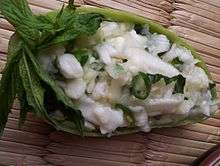Singju
 A Typical Manipuri Cuisine, Singju. Yongchaak Singju type is shown here. | |
| Place of origin | India |
|---|---|
| Region or state | Manipur |
| Variations | seasonal vegetables |
Singju (pronounce as sing-zoo) is a typical Manipur salad-type dish. It originated from the Meitei but is also well eaten by most of the sibling communities of the state and in some neighbouring states of Northeast India. Singju has been the all-time favourite side dish for meals (other being eromba) and as afternoon or evening snacks too. Meanwhile, eromba should not be confused with singju. Eromba is usually not eaten as snacks while singju is.
Singju has many varieties as much as eromba, because of its seasonal vegetables which are the main ingredients of it. Like eromba, singju is of two types, Veg and Non-veg. The veg type are mainly served at ritual occasions while the non-veg type are eaten at homes.
History

Manipur, being one of the oldest ancient independent kingdoms of East/Southeast/Central Asia, Siberia, Micronesia and Polynesia, before being a part of India in 1949, has varieties of customs and traditions, owing to various influences through time. The word "Singju" comes from two words - "Manaa-Masing" and "Suba". "Manaa-Masing" means green vegetables and "Suba" means combining. Therefore, in rapid pronunciation the word "Manaa-Masing" drops to "Sing" and the word "Suba" transform to "Ju" for the better pronouncement. As a result, the word, "Singju" was born.
Preparation
.jpg)
Singju being a versetile cuisine i.e. both veg and non veg. There are two different ways to prepare singju cuisine.
Veggie Singju
A veggie singju is mainly served in ritual feasts of the Meitei where they observe at their house courtyard or shrines' yard or community complexes. It can be eaten at homes too but usually people prefer the non veg one at homes.
In this type, the main ingredients are perilla seeds (thoiding in Meitei), chanaa powder, salt, chillies and green leafy vegetables (compatible vegetables' list are listed below and its season).
Non-veg Singju
A non veg singju is mainly eaten at homes and are widely sold in restaurants all over Manipur and in some places of India too. The tag "non-veg" is because of the fermented fish call Ngari use as its ingredient. Because of this, it can not be served in ritual feasts of the community. But if one want to try the real taste of Singju, one better try the non-veg type.
In this type, the main ingredients are Ngari (a manipuri fermented fish), salt, chillies and green leafy vegetables (compatible vegetables' list are listed below and it is seasonal).[1]
Some famous Singju Ingredients

Any vegetables can make a delicious singju. But meanwhile here are some famous ingredients which are being used for making singju. There are, absolutely, some hot delicious vegetable combinations but not all the below vegetables at the same singju.
- Lotus stem (Thambou in Meitei)
- Stink Bean (Yongchaak)
- Cabbage (Kobiful)
- Cauliflower (Kobi-Lei)
- Hawai Debi or Tebi
- Hawai Maton
- Unripe Papaya (Awaa Thabi)
- Banana Flower (Laphu Tharo)
- Rice Bean (Chakhawai)
- Onion (Tilhou)
- And much more.
Morok Metpa or Ametpa

Morok Metpa or Ametpa is another singju like dish. Morok means chilli and Metpa/Ametpa meaning crush. It is traditionally eaten along with daily meals at home but are not served at rituals. Like singju, it can be prepared in two ways, veg and non-veg, the former is usually eaten during the mourning period until the shraddha ceremony or on days when people skip any type of meat due to religious beliefs. It is usually made by frying red chillies, chives and onions as opposed to the usual steamed or roasted fermented fish and chillies eaten everyday.
See also
- Cuisine of Manipur
- Eromba
- Poke - a similar dish from Hawaii, United States
References
External links
| Wikimedia Commons has media related to Singju. |